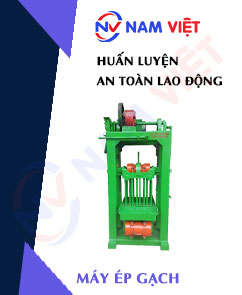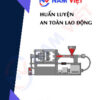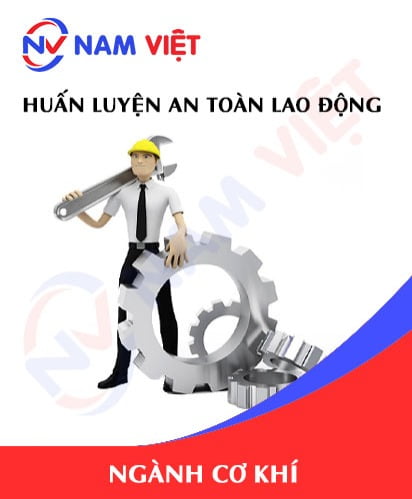Occupational Safety Training for Operating Brick Press Machines
99,000 ₫
Note: The price above is calculated per person and may fluctuate depending on the number of participants in the course and market conditions. For more accurate pricing support, please refer to the price list or contact our consulting staff directly.
Occupational safety is an important issue when operating a brick press machine and must be addressed promptly to ensure the health and safety of workers and enhance the reputation of businesses here. The Occupational Safety Training course is one of the effective solutions to raise awareness of how to prevent workplace accidents for workers operating a brick press machine.
Table of Contents
Toggle1. Overview of the Brick Press Machine
a. What is a Brick Press Machine?
A brick press machine is an industrial device used to produce bricks from materials such as clay, sand, cement, and water. This process typically involves placing the material mixture into the machine, where it is compressed and molded into bricks of specific shapes and sizes. This makes brick production more efficient and uniform compared to manual methods. Brick press machines are commonly used in the construction industry to produce high-quality bricks that meet the high demands of construction projects.

b. How the Brick Press Machine Works
The operation of a brick press machine generally follows these steps:
- Material preparation: The main materials include clay, sand, cement, and water. These components are mixed in precise proportions to create a suitable mixture for pressing.
- Mixing: The material mixture is fed into the press machine, where it is thoroughly mixed to achieve a homogeneous blend.
- Pressing: The mixture is placed into molds of the desired shape and size. The machine then applies high pressure to compress the mixture and form bricks.
- Inspection and drying: The bricks are inspected for quality and then directed to the drying process. Drying helps the bricks harden and retain their shape.
- Firing (if needed): In some cases, bricks may need to be fired in a kiln to increase hardness and durability.

c. Industries Using Brick Press Machines
Brick press machines are primarily used in the construction industry for producing bricks and blocks for construction projects. Specific industries include:
- Construction: Brick press machines are essential for producing construction bricks used in residential buildings, commercial buildings, and infrastructure projects.
- Construction materials industry: Companies specializing in producing and supplying building materials use brick press machines to improve efficiency and product quality.
- Light brick manufacturing: Brick press machines can also be used in the production of lightweight bricks, which are widely used in construction.
- Floor tile industry: In floor tile production, brick press machines can produce large tiles with consistent dimensions and thickness.
2. Overview of Safety Training for Operating Brick Press Machines
a. What is Occupational Safety Training?
- Occupational safety training for operating brick press machines consists of sessions that provide workers with awareness and prevention strategies for workplace accidents. Workers directly operating brick press machines belong to Group 3.
- This training helps workers identify and avoid hazards, reducing the risk of workplace accidents during operations.
REGISTER FOR OCCUPATIONAL SAFETY TRAINING
b. Training Duration
Initial safety training duration:
- Total training time is at least 24 hours, including testing time.
- 8 hours of theory on safety policies and labor hygiene laws
- 8 hours of theory on basic occupational safety and hygiene knowledge
- 4 hours of theory on specialized training content
- 2 hours of practical exercises on specialized training content
- 2 hours of final theory assessment
Safety training centers usually divide the training into multiple sessions depending on workers’ schedules. Typically, there are 6 sessions over 3 days, assuming the employer can allocate continuous learning time.
Periodic safety training duration:
- Before the occupational safety card expires, workers must undergo periodic safety training to renew it, with training duration at least 50% of the initial training duration.
Explanation: Total periodic safety training is at least 12 hours, including testing. After completing the training and passing the test, workers receive renewed safety cards.
c. Training Content
| No. | TRAINING CONTENT | TRAINING DURATION (HOURS) | |||
| Total | Breakdown | ||||
| Theory | Practical | Test | |||
| I | Safety policies and labor hygiene laws | 8 | 8 | 0 | 0 |
| 1 | Overview of the legal framework for occupational safety and hygiene. | 6 | 6 | ||
| 2 | Standards and technical regulations for occupational safety and hygiene. | 1 | 1 | ||
| 3 | Specific regulations by state management agencies on safety and hygiene during new construction, expansion, or renovation of facilities, and for the use, storage, and inspection of machines, equipment, materials, and substances with strict safety requirements. | 1 | 1 | ||
| II | Basic knowledge of occupational safety and hygiene | 8 | 8 | 0 | 0 |
| 1 | Basic knowledge of hazardous and harmful factors in the workplace. | 4 | 4 | ||
| 2 | Methods to improve working conditions. | 1 | 1 | ||
| 3 | Safety culture in production and business. | 1 | 1 | ||
| 4 | Rights and obligations of employers and employees; policies and regimes on occupational safety and hygiene; functions of safety networks and hygiene officers. | 1 | 1 | ||
| 5 | Safety regulations, signage, use of safety equipment and personal protective gear; skills in first aid and occupational disease prevention. | 1 | 1 | ||
| III | Specialized training content | 6 | 4 | 2 | 0 |
| Comprehensive knowledge of machines, equipment, hazardous substances; risk analysis, evaluation, and management; safe working procedures with machines, equipment, and substances with strict safety requirements. | 6 | 4 | 2 | ||
| IV | Final safety training assessment | 2 | 2 | 0 | 0 |
| Total | 24 | 22 | 2 | ||
See more training content of all 6 groups
d. Occupational Safety Card
After completing the occupational safety training and passing the assessment, workers are issued an occupational safety card (commonly referred to as a Group 3 safety certificate).
The Group 3 safety card displays personal information such as name, date of birth, job, and work environment. It also includes training duration, an official seal, and signature confirming completion of training.
According to Clause 2 of Article 24 of Decree 44/2016/ND-CP, there are two cases:
- If the employer and employee have a labor contract, the employer must sign, stamp, and validate the safety card after the employee completes the training from the occupational safety training provider and passes the assessment.
- If the worker is freelance or seasonal and does not have a labor contract, the training provider must sign, stamp, and validate the safety card after the worker completes the training and passes the assessment.

3. Hazards When Operating Brick Press Machines
Operating a brick press machine must be done safely to avoid potential hazards. Below are some hazards workers may face when operating a brick press machine:
- Physical injuries: The risk of injury is very high if safety rules are not followed. This includes the risk of being caught in the machine, colliding with moving parts, or getting injured during maintenance.
- Explosion hazards: In cases where brick production involves high temperatures or melting processes, there is a risk of explosion or fire. Safety in this process requires special attention to temperature control and the quality of raw materials.
- Chemical hazards: If the machine uses chemicals during brick production, the risk of exposure must be assessed and controlled to protect workers’ health.
- Dust and fumes: The pressing and firing processes can generate dust and fumes, posing health risks to workers if appropriate control and protection measures are not in place.
- Noise: Brick press machines can produce high noise levels, and prolonged exposure to loud sounds can damage hearing.
To minimize these hazards, it is important to follow safety rules, properly train workers, and implement risk control measures.

4. Occupational Accident Control Measures When Operating Brick Press Machines
To control occupational accidents when operating brick press machines, the following safety measures can be implemented:
- Training and guidance: Ensure that all employees operating the machine are fully trained in safety rules and proper work procedures.
- Use of personal protective equipment (PPE): Require workers to wear PPE such as helmets, safety glasses, gloves, and safety shoes to reduce the risk of injury.
- Regular inspection and maintenance: Conduct regular inspections and maintenance of the press machine to ensure it operates correctly and has no technical faults that could pose a danger.
- Dust and fume control: Use dust and fume extraction systems to minimize their impact on workers’ health.
- Explosion risk management: If the brick production process involves high temperatures or flammable liquids, apply explosion prevention measures such as fire suppression systems and temperature control.
- Periodic safety monitoring and inspection: Conduct regular checks and supervision to ensure all safety rules are followed and potential problems are detected early.
- Organize the workspace: Ensure the area around the brick press machine is tidy, free from obstacles, and provides safe passageways.
- Limit exposure to hazardous substances: If the machine uses toxic substances, ensure measures are in place to control and minimize worker exposure.
- Periodic inspection of the brick press machine to detect safety issues such as wear, damage, or mechanical failures, thereby reducing the risk of occupational accidents.
5. Benefits of Occupational Safety Training
An Toàn Nam Việt provides the following benefits to businesses upon completing occupational safety training courses in accordance with Decree 44/2016/ND-CP on occupational health and safety:
- Workers can identify potential accident hazards and take preventive measures to avoid workplace accidents.
- Businesses can establish risk prevention measures in production, operation, and maintenance processes.
- Reduce costs associated with safety incidents.
- Uninterrupted production helps increase labor productivity and product quality.
- Ensure compliance with occupational safety laws, avoiding legal risks.
- Enhance credibility and professionalism, boosting the company’s brand image.
Nam Việt’s training courses provide solutions to prevent and protect individuals from external hazards that could cause injury or even death.
REGISTER FOR OCCUPATIONAL SAFETY TRAINING SERVICES
6. Customer Feedback After Completing Training
An Toàn Nam Việt has years of experience supporting businesses in Vietnam, particularly in the southern provinces. This responsibility is extremely valuable, which is why Nam Việt’s Occupational Safety Training is increasingly professional. Our growth is driven by positive feedback and suggestions from businesses. Below are testimonials from our partners.
Bac Nam E&C Investment Construction Joint Stock Company
“My first experience with An Toàn Nam Việt surprised me due to the 24/7 support from their consultants. The training organization was quick and convenient for our company. Thank you very much for Nam Viet’s service!”
Hoa Dat Construction & Trading Joint Stock Company
“Nam Viet’s service greatly helped us simplify occupational safety and complete safety documentation for work. The consultants were enthusiastic and timely in answering our questions. Five stars for Nam Viet.”
See more customer interviews after using our services at An Toàn Nam Việt
7. An Toàn Nam Việt’s Occupational Safety Training Capacity
An Toàn Nam Việt is a reputable and high-quality occupational safety training center in Vietnam. Our training sessions are conducted continuously at production workshops, factories, or construction sites across all 63 provinces of Vietnam.
REGISTER FOR OCCUPATIONAL SAFETY TRAINING SERVICES
Occupational safety training license
- An Toàn Nam Việt has been inspected and certified by the Safety Department of the Ministry of Labor – Invalids and Social Affairs, confirming our qualifications for conducting occupational safety and hygiene training, further solidifying our training capability.

Materials and lectures
- Training materials are reviewed and approved before use in occupational safety training courses to ensure knowledge accuracy and practical effectiveness.
- Instructor teaching methods are standardized according to An Toàn Nam Việt’s standards, developed by occupational safety experts to maximize knowledge retention for trainees.
Facilities
- Controlling classroom factors affecting training improves teaching efficiency and knowledge absorption.
- Our training facilities provide spacious classrooms with standard lighting and equipment.
8. Nationwide Reputable Occupational Safety Training Center
At An Toàn Nam Việt, we prioritize occupational safety training professionalism. Teaching workers self-protection skills equips them for safe livelihoods and contributes to nation-building.
We carefully prepare all tools, teaching equipment, curricula, materials, sound, and lighting to ensure effective training.
Our instructors are experienced experts, some with research on hazard identification across industries and preventive methods.
Lectures are practical, vivid, and easy to understand, allowing workers to comfortably absorb knowledge, always aligned with Decree 44/2016/ND-CP.
Trainees learn hazard prevention measures and how to apply them effectively in their work.
Our training center proudly provides professional, reputable occupational safety training with advantages such as:
- Competitive training costs without compromising quality.
- Flexible training schedules aligned with company production.
- Fast and compliant certification procedures.
- Experienced instructors with years in the field.
- Classrooms optimized for learning efficiency and knowledge retention.
- Course content tailored to occupational safety in businesses.
- Dedicated and professional service ensuring accurate, fast support for clients.

9. Additional Occupational Safety Training Resources
1 review for Occupational Safety Training for Operating Brick Press Machines
No comments yet















phanminhhang341
Hài lòng với cách tổ chức lớp học